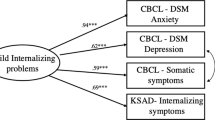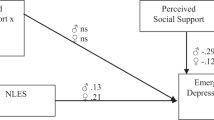Abstract
Maternal depression may affect children through various mechanisms, including the stressful contexts of the children’s lives and maternal maladaptive affection, behaviors, and cognition, which affect the psychopathological development of children and contribute to disorders. The aims of the present study were to explore how family functioning mediates the relationship between maternal depression and the positive and negative emotions of adolescents. A total of 430 paired questionnaires were collected from junior high school students and their mothers. The mothers completed the Center for Epidemiologic Studies Depression Scale (CESD), and the adolescents completed the CESD, Mood and Anxiety Symptom Questionnaire, and Family Function Scale. The results revealed significant correlations among maternal depression, family functioning, and positive and negative emotions in the adolescents. The family functioning subscales of conflict and emotional expression partially mediated the relationship between maternal depression and the positive and negative emotions of the adolescents. Furthermore, the family functioning subscales of cohesion, problem solving, and responsibility fully mediated the relationship between maternal depression and positive moods in the adolescents. Analysis of the results for maternal depression, family functioning, and the emotional adjustment of the adolescents indicated that family functioning is the mediator between maternal depression and the positive and negative emotions of the adolescents. The current results suggest that adequate family functioning can prevent depression being transmitted from mothers to their adolescent children.

Similar content being viewed by others
References
Badger, T. A. (1996). Family members’ experiences living with members with depression. Western Journal of Nursing Research, 18(2), 149–171.
Baron, R. M., & Kenny, D. A. (1986). The moderator–mediator variable distinction in social psychological research: Conceptual, strategic, and statistical considerations. Journal of Personality and Social Psychology, 51(6), 1173–1182.
Beardselee, W. R., Versage, E. M., & Giadstone, T. R. G. (1998). Children of affectively ill parents: A review of the past 10 years. Journal of the American Academy of Child and Adolescent Psychiatry, 37(11), 1134–1141.
Beardslee, W. R., Gladstone, T. R., & O’Connor, E. E. (2011). Transmission and prevention of mood disorders among children of affectively ill parents: A review. Journal of the American Academy of Child and Adolescent Psychiatry, 50(11), 1098–1109.
Black, K., & Lobo, M. (2008). A conceptual review of family resilience factors. Journal of Family Nursing, 14(1), 33–55.
Burke, L. (2003). The impact of maternal depression on familial relationships. International Review of Psychiatry, 15(3), 243–255.
Burt, K. B., Van Dulmen, M. H. M., Carlivati, J., Egeland, B., Alan Sroufe, L., Forman, D. R., & Carlson, E. A. (2005). Mediating links between maternal depression and offspring psychopathology: the importance of independent data. Journal of Child Psychology and Psychiatry, 46(5), 490–499.
Clark, L. A., & Watson, D. (1991). Tripartite model of anxiety and depression: psychometric evidence and taxonomic implications. Journal of Abnormal Psychology, 100(3), 316–336.
Cummings, E. M., Keller, P. S., & Davies, P. T. (2005). Towards a family process model of maternal and paternal depressive symptoms: Exploring multiple relations with child and family functioning. Journal of Child Psychology and Psychiatry, 46(5), 479–489.
De Ross, R., Marrinan, S., Schattner, S., & Gullone, E. (1999). The relationship between perceived family environment and psychological wellbeing: Mother, father, and adolescent reports. Australian Psychologist, 34(1), 58–63.
Dix, T., & Meunier, L. N. (2009). Depressive symptoms and parenting competence: An analysis of 13 regulatory processes. Developmental Review, 29(1), 45–68.
Epstein, N. B., Bishop, D. S., & Levin, S. (1978). The McMaster model of family functioning. Journal of Marital and Family Therapy, 4(4), 19–31.
Fan, Y. (2000). A classification of Chinese culture. Cross Cultural Management: An International Journal, 7(2), 3–10.
Focht-Birkerts, L., & Beardslee, W. R. (2000). A Child’s Experience of Parental Depression: Encouraging Relational Resilience in Families with Affective Illness. Family Process, 39(4), 417–434.
Goodman, S. H. (2007). Depression in mothers. Annual Review of Clinical Psychology, 3, 107–135.
Goodman, S. H., & Gotlib, I. H. (1999). Risk for psychopathology in the children of depressed mothers: A developmental model for understanding mechanisms of transmission. Psychological Review, 106(3), 458–490.
Goodman, S. H., Rouse, M. H., Connell, A. M., Broth, M. R., Hall, C. M., & Heyward, D. (2011). Maternal depression and child psychopathology: A meta-analytic review. Clinical Child and Family Psychology Review, 14, 1–27.
Hammen, C., & Brennan, P. A. (2003). Severity, chronicity, and timing of maternal depression and risk for adolescent offspring diagnoses in a community sample. Archives of General Psychiatry, 60(3), 253–258.
Hammen, C., Shih, J., Altman, T., & Brennan, P. A. (2003). Interpersonal impairment and the prediction of depressive symptoms in adolescent children of depressed and nondepressed mothers. Journal of the American Academy of Child and Adolescent Psychiatry, 42(5), 571–577.
Hammen, C., Shih, J. H., & Brennan, P. A. (2004). Intergenerational transmission of depression: Test of an interpersonal stress model in a community sample. Journal of Consulting and Clinical Psychology, 72(3), 511–522.
Hilbert, G. A. (1994). Cardiac patients and spouses: Family functioning and emotions. Clinical Nursing Research, 3(3), 243–252.
Hollingshead, A. B. (1957). Two factor index of social position. Mimeo. New Haven, Connecticut: Yale University.
Hollingshead, A. B. (1971). Commentary on the indiscriminate state of social class measurement. Social Forces, 49(4), 563–567.
Hughes, E. K., & Gullone, E. (2008). Internalizing symptoms and disorders in families of adolescents: A review of family systems literature. Clinical Psychology Review, 28(1), 92–117.
Jacques, H. A. K., & Mash, E. J. (2004). A test of the tripartite model of anxiety and depression in elementary and high school boys and girls. Journal of Abnormal Child Psychology, 32(1), 13–25.
Kessler, R.C. (2006). The epidemiology of depression among women. Women and depression: A handbook for the social, behavioral, and biomedical sciences. London, Cambridge University Press.
Leung, S. S. K., Stewart, S. M., Wong, J. P. S., Ho, D. S. Y., Fong, D. Y. T., & Lam, T. H. (2009). The association between adolescents’ depressive symptoms, maternal negative affect, and family relationships in Hong Kong: Cross-sectional and longitudinal findings. Journal of Family Psychology, 23(5), 636–645.
Lovejoy, M. C., Graczyk, P. A., O’Hare, E., & Neuman, G. (2000). Maternal depression and parenting behavior: A meta-analytic review. Clinical Psychology Review, 20(5), 561–592.
Murphy, G., & Murphy, L. B. (1968). Asian psychology. New York: Basic Books.
Nelson, D. R., Hammen, C., Brennan, P. A., & Ullman, J. B. (2003). The impact of maternal depression on adolescent adjustment: The role of expressed emotion. Journal of Consulting and Clinical Psychology, 71(5), 935–944.
Pakenham, K. I., & Cox, Stephen. (2012). Test of a model of the effects of parental illness on youth and family functioning. Health Psychology, 31(5), 580–590.
Parsons, T., & Bales, R. F. (1956). Family, socialization and interaction process. London: Routledge & Kegan Paul.
Pedersen, S., & Revenson, T. A. (2005). Parental illness, family functioning, and adolescent well-being: A family ecology framework to guide research. Journal of Family Psychology, 19(3), 404.
Preacher, K. J., & Hayes, A. F. (2004). SPSS and SAS procedures for estimating indirect effects in simple mediation models. Behavior Research Methods, Instruments, & Computers, 36, 717–731.
Radloff, L. S. (1977). The CES-D scale: A self-report depression scale for research in the general population. Applied Psychological Measurement, 1(3), 385–401.
Ramchandani, P. G., & Murphy, S. E. (2013). Parental depression and the challenge of preventing mental illness in children. The British Journal of Psychiatry, 202(2), 84–85.
Restifo, K., & Bögels, S. (2009). Family processes in the development of youth depression: Translating the evidence to treatment. Clinical Psychology Review, 29(4), 294–316.
Riley, A. W., Valdez, C. R., Barrueco, S., Mills, C., Beardslee, W., Sandler, I., & Rawal, P. (2008). Development of a family-based program to reduce risk and promote resilience among families affected by maternal depression: theoretical basis and program description. Clinical Child and Family Psychology Review, 11(1–2), 12–29.
Rose, B. M., Holmbeck, G. N., Coakley, R. M., & Franks, E. A. (2004). Mediator and moderator effects in developmental and behavioral pediatric research. Journal of Developmental and Behavioral Pediatrics, 25(1), 58–67.
Sarigiani, P. A., Heath, P. A., & Camarena, P. M. (2003). The significance of parental depressed mood for young adolescents’ emotional and family experiences. The Journal of Early Adolescence, 23(3), 241–267.
Sheeber, L., Hops, H., & Davis, B. (2001). Family processes in adolescent depression. Clinical Child and Family Psychology Review, 4(1), 19–35.
Shiner, R., & Marmorstein, N. R. (1998). Family environments of adolescents with lifetime depression: Associations with maternal depression history. Journal of the American Academy of Child and Adolescent Psychiatry, 37(11), 1152–1160.
Somerset, W., Newport, D. J., Raga, K., & Stowe, Z. N. (2006). Depressive disorders in women. In L. M. Corey & S. H. Goodman (Eds.), Women and depression: A handbook for the social, behavioral, and biomedical sciences (pp. 62–88). New York: Cambridge University Press.
Thomas, E. J., Catanzaro, S. J., & Laurent, J. (1996). Tripartite structure of positive and negative affect, depression, and anxiety in child and adolescent psychiatric inpatients. Journal of Abnormal Psychology, 105(3), 401–409.
Tompson, M. C., Pierre, C. B., Boger, K. D., McKowen, J. W., Chan, P. T., & Freed, R. D. (2010). Maternal depression, maternal expressed emotion, and youth psychopathology. Journal of Abnormal Child Psychology, 38(1), 105–117.
Towe-Goodman, N. R., & Teti, D. M. (2008). Power assertive discipline, maternal emotional involvement, and child adjustment. Journal of Family Psychology, 22(4), 648.
Vandewater, E. A., & Lansford, J. E. (2005). A family process model of problem behaviors in adolescents. Journal of Marriage and Family, 67(1), 100–109.
Walsh, F. (1993). Normal Family Process. New York: Guilford Press.
Wang, S.H. (2001) Family function and personality in woman with depression only, anxiety only, and mixed anxiety-depression. Theses of Institute of Behavior and Medicine, National Cheng Kung University. Taiwan.
Yang, H. J., Soong, W. T., Kuo, P. H., Chang, H. L., & Chen, W. J. (2004). Using the CES-D in a two-phase survey for depressive disorders among nonreferred adolescents in Taipei: A stratum-specific likelihood ratio analysis. Journal of Affective Disorders, 82, 419–430.
Yeh, Z. T. (2003). Anxiety and depression-testing a tripartite model. Formosa Journal of Mental Health, 16(2), 87–111.
Author information
Authors and Affiliations
Corresponding author
Rights and permissions
About this article
Cite this article
Yeh, ZT., Huang, Yh. & Liu, SI. Maternal Depression and Adolescent Emotions: The Role of Family Functioning. J Child Fam Stud 25, 2189–2200 (2016). https://doi.org/10.1007/s10826-016-0399-4
Published:
Issue Date:
DOI: https://doi.org/10.1007/s10826-016-0399-4




